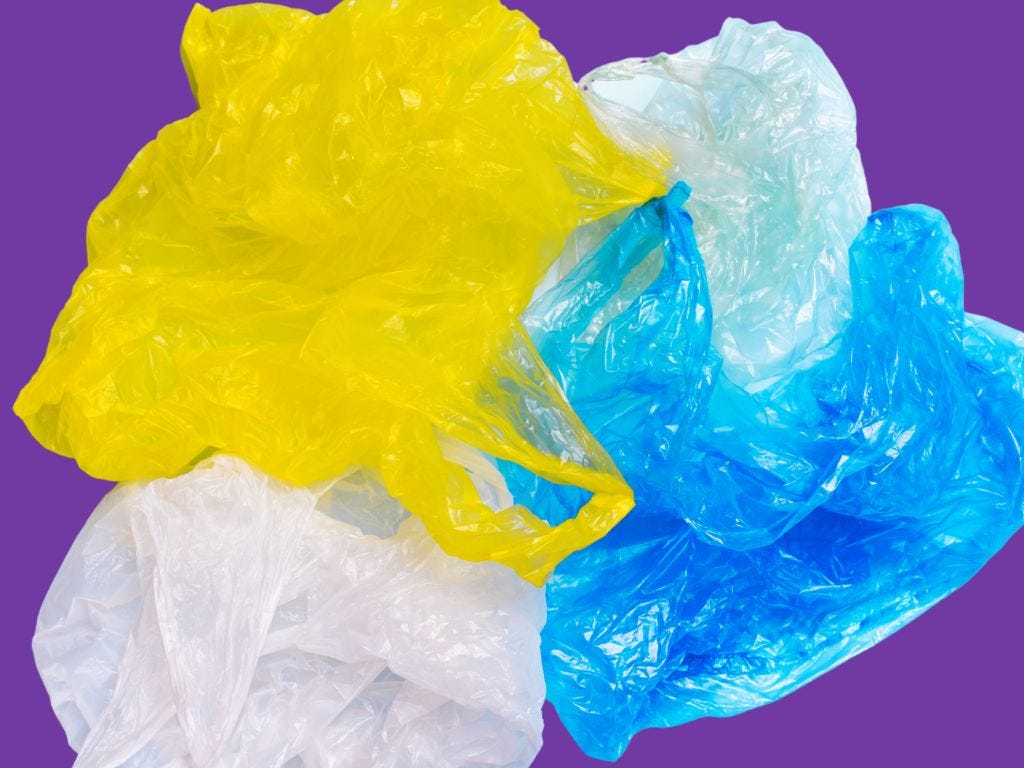Microplastics are in your brain 🧠 now what?
How tiny plastics get into our bodies and what that means for our health
This is a reader-suggested topic, up-voted in the chat. If you’d like to suggest a topic or vote, you can find the link here.
Plastic waste doesn’t just end up in the landfill, or get recycled.
Tiny bits of it, called microplastics, are ending up in our bodies.
Some headlines claim we’re eating about 5 grams of microplastics every week, the weight of a credit card.
While new research shows this stat might be way off, even if we’re eating less, the fact that we’re eating any is concerning.
So what are microplastics doing to our brain, gut, and overall health?
And 7 ways to limit your exposure to microplastics.
What we’ll cover today:
What are microplastics? Tiny plastic bits sneaking into our food, water, and air.
Are we really eating a credit card’s worth of plastic each week? The truth behind the headline.
How microplastics affect our health. What they do to our brain, gut, and body.
Where they’re hiding. The surprising places microplastics show up.
Easy ways to cut down on them. Simple swaps to lower your exposure (paid subscribers only).
What are microplastics?
Microplastics are tiny plastic pieces smaller than 5mm (about the size of a head of a matchstick) that come from bigger plastic items breaking down.
Even tinier are nanoplastics, which are so small, they’re able to slip into our cells.
They’re now found everywhere - our food, water, air, and even in human organs like the liver, kidneys, and brain.
In total, around 10 to 40 million tonnes of microplastics leak into the environment every year - enough to fill roughly one to eight truckloads per minute - not just into the sea, but also into soil, rivers, and the air we breathe.
One study found that the most common type of microplastics in the human brain was polyethylene, the most common plastic used in packaging, like shopping bags, food wrappings, cups and bottles.
Do we really eat a credit card’s worth of plastic each week?
The shocking claim that we eat 5 grams a week, equivalent to a credit card, turns out to be flawed.
New research puts it closer to 4.1 micrograms a week, meaning you’d need 23,000 years to swallow one credit card’s worth of plastic.
Still, it’s not good news.
Even tiny amounts of microplastics can slip into our cells and organs, and that could pose serious health risks in the long run.
For now though, there’s limited evidence that they impact human health - but that could change in the future.
Alarming early warnings
While research is still ongoing, early studies hint at how accumulating microplastics in our bodies have the potential to be harmful:
They can get into our organs: Microplastics have been found in the brain, liver, and gut. They have also been detected in human blood, suggesting they can move through the body.
They may affect hormones: Some chemicals found in plastics have been shown to disrupt hormones in animal studies, but it’s unclear whether microplastics themselves have the same effect in humans.
Some plastics carry harmful chemicals: Microplastics can absorb pollutants like pesticides and heavy metals from the environment and may release them in the body, but the health impact is still being studied.
Most health effects are based on animal studies, with limited human data.
Meaning that we don’t truly know yet how microplastics affect us as humans.
Microplastics are reaching our brains
Scientists have found microplastics in human brains, and not just a little.
Some people had 30 times more microplastics in their brains than in their liver or kidneys.
Even more concerning, people with dementia had much higher levels of microplastics, especially near blood vessels and immune cells.
This doesn’t prove that microplastics cause dementia, but it raises big questions.
Since 2016, the amount of microplastics in human brains has shot up by 50%, likely because plastic pollution keeps increasing.
Microplastics and your gut microbiome
Microplastics aren’t just passing through our bodies.
There’s some early evidence in animal studies and simulated human models that microplastics can disrupt the gut microbiome, and may contribute to excess inflammation.
Again though, evidence in humans is lacking.
Scientists are still figuring out exactly how much of an impact they have.
What we do know is that microplastics are everywhere, and they aren’t completely harmless.
Microplastics are (almost) everywhere
Some common sources are:
Food: Fish, salt, honey, and even fruits and veggies absorb microplastics from the soil and water.
Water: Both bottled and tap water contain them (bottled water, though, contains far higher levels).
Air: We breathe in microplastics every day, especially indoors, where dust and fabrics shed tiny particles.
7 ways to limit microplastics
We can’t escape microplastics completely, but making a few simple swaps can help lower how much you’re exposed to them.
Here are 7 practical tips (and some of the evidence behind them):
Keep reading with a 7-day free trial
Subscribe to Second Brain to keep reading this post and get 7 days of free access to the full post archives.












